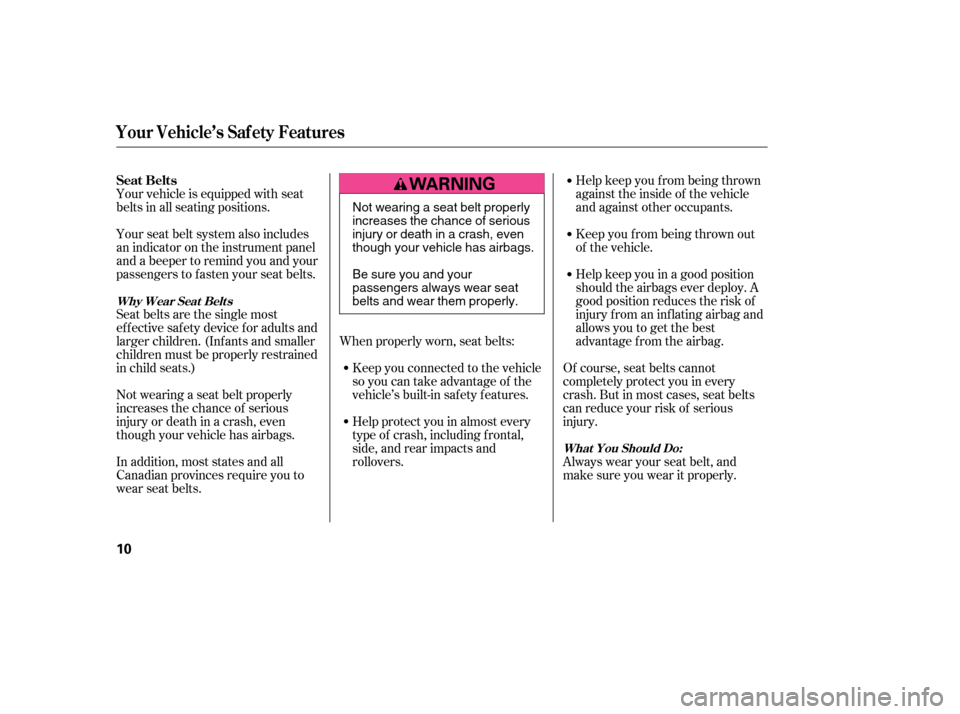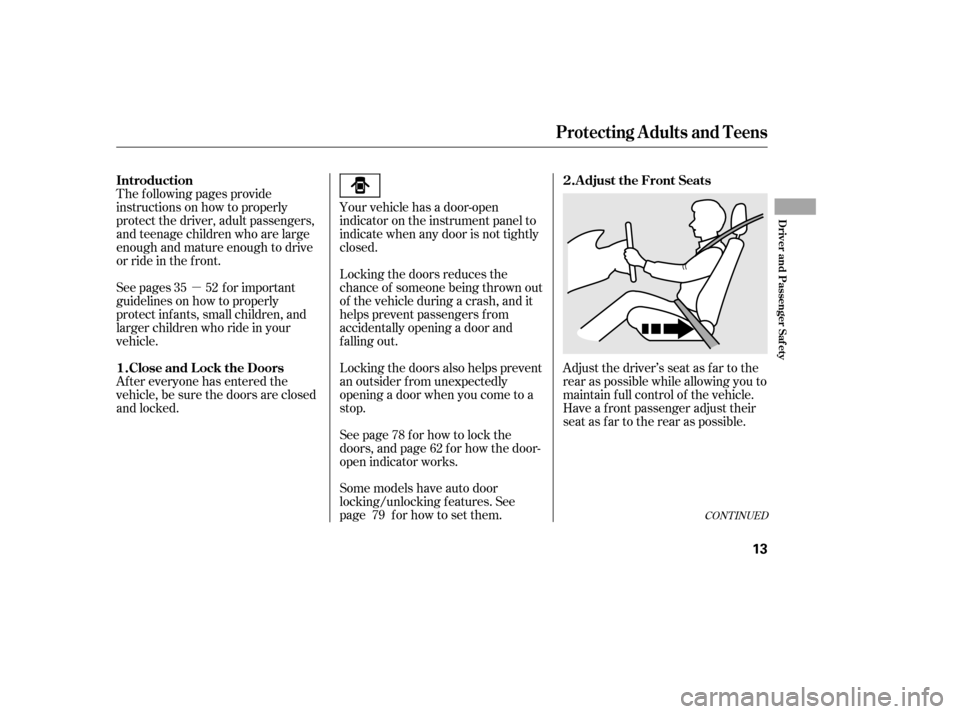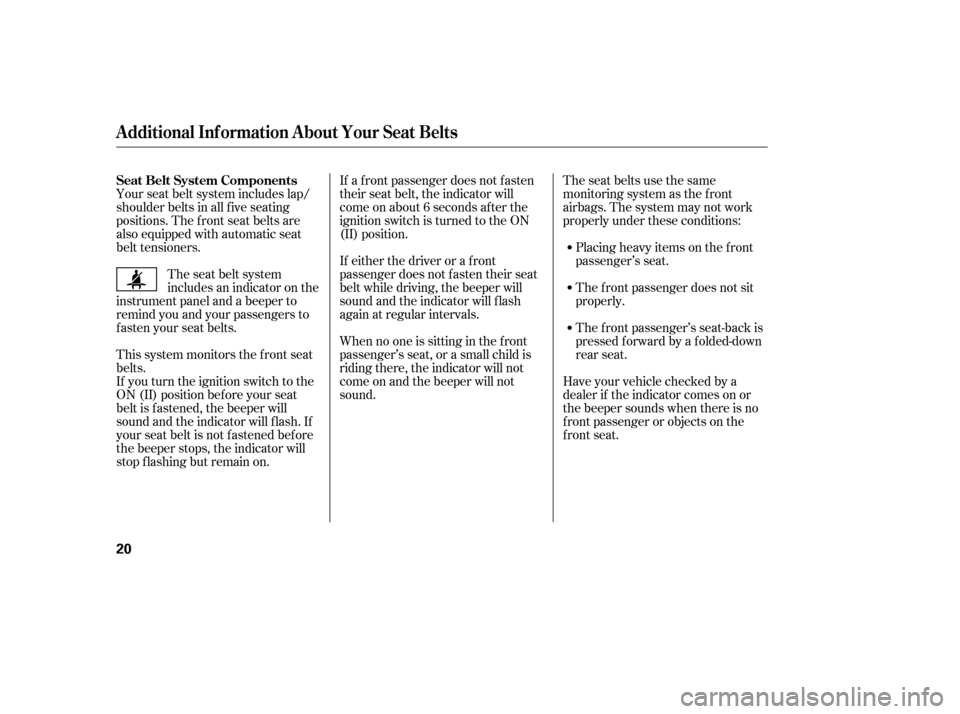Page 1 of 253
�Î
�Î�Î
�Î
: If equipped
Your Vehicle at a Glance
4
POWER WINDOW
SWITCHESGAUGES
POWER DOOR LOCK
MASTER SWITCH FUEL FILL DOOR
RELEASE HANDLE TRUNK RELEASE
HANDLE
DRIVER’S FRONT
AIRBAG
HEATING/COOLING
CONTROLS
AUTOMATIC
TRANSMISSIONMANUAL
TRANSMISSION
MIRROR CONTROLS
INSTRUMENT PANEL INDICATORS
AUDIO SYSTEMMOONROOF SWITCH
(P. 59)
(P. 65)
(P. 11, 26) (P. 96)
(P. 78)
(P. 93) (P. 151)(P. 84) (P. 106)
(P. 94)
(P. 11, 26)
(P. 102)(P. 78)
(P. 166) (P. 164)(P. 100)
Vehicle with navigation system is shown. PASSENGER’S FRONT AIRBAG
DOOR LOCK TABACCESSORY
POWER SOCKET
AUXILIARY INPUT JACK (P. 143)
�����—�����—���
�y�
�����������
�y���
�(�#���������y���������y
Page 2 of 253
�Î �Î�Î
�Î
�Î
�Î�Î
�Î
To use the horn, press the pad around the ‘‘H’’ logo.
Only on vehicles equipped with navigation system. Ref er to the navigati on system manual.
:
1: 2: If equipped
Your Vehicle at a Glance
Your Vehicle at a Glance
5
HEADLIGHTS/TURN SIGNALS
DISPLAY CHANGE
BUTTON
(P. 65)
SEL/RESET
BUTTON
REMOTE AUDIO
CONTROLS VOICE CONTROL
SWITCHES
STEERING WHEEL
ADJUSTMENT HAZARD WARNING BUTTON
PASSENGER AIRBAG OFF
INDICATOR
HORN REAR WINDOW DEFOGGER
(P. 73)
(P. 72)
(P. 65)
(P. 143)
(P. 152) (P. 73)(P. 71)
(P. 70)
(P. 32)
(P. 72)(P. 97)
(P. 145)
HOOD RELEASE
HANDLE WINDSHIELD WIPERS/WASHERS
HEATED MIRRORS
CRUISE CONTROL BUTTONS
Vehicle with navigation system is shown. INSTRUMENT PANEL
BRIGHTNESS BUTTONS
1
2 1
1
�����—�����—���
�y�
�������������y���
�(�#���������y���������y
Page 6 of 253

Your vehicle is equipped with seat
belts in all seating positions.
Seat belts are the single most
effectivesafetydeviceforadultsand
larger children. (Inf ants and smaller
children must be properly restrained
in child seats.)
Not wearing a seat belt properly
increases the chance of serious
injury or death in a crash, even
though your vehicle has airbags.
In addition, most states and all
Canadian provinces require you to
wear seat belts.When properly worn, seat belts:
Keep you connected to the vehicle
so you can take advantage of the
vehicle’s built-in saf ety f eatures.
Help protect you in almost every
type of crash, including f rontal,
side, and rear impacts and
rollovers. Help keep you f rom being thrown
against the inside of the vehicle
and against other occupants.
Keep you f rom being thrown out
of the vehicle.
Help keep you in a good position
should the airbags ever deploy. A
good position reduces the risk of
injury f rom an inf lating airbag and
allows you to get the best
advantage f rom the airbag.
Of course, seat belts cannot
completely protect you in every
crash.Butinmostcases,seatbelts
can reduce your risk of serious
injury.
Always wear your seat belt, and
make sure you wear it properly.
Your seat belt system also includes
an indicator on the instrument panel
and a beeper to remind you and your
passengers to f asten your seat belts.
Your Vehicle’s Saf ety Features
Seat Belts
Why Wear Seat Belt s
What You Should Do:
10
Not wearing a seat belt properly
increases the chance of serious
injury or death in a crash, even
though your vehicle has airbags.
Be sure you and your
passengers always wear seat
belts and wear them properly.
�����—�����—�����y�
�������������y���
�(�#���������y�����
���y
Page 9 of 253

�µAdjust the driver’s seat as far to the
rear as possible while allowing you to
maintain f ull control of the vehicle.
Have a front passenger adjust their
seat as far to the rear as possible.
The f ollowing pages provide
instructions on how to properly
protect the driver, adult passengers,
and teenage children who are large
enough and mature enough to drive
or ride in the f ront.
See pages f or important
guidelines on how to properly
protect inf ants, small children, and
larger children who ride in your
vehicle.
Af ter everyone has entered the
vehicle, be sure the doors are closed
and locked.
Your vehicle has a door-open
indicator on the instrument panel to
indicate when any door is not tightly
closed.
Locking the doors reduces the
chance of someone being thrown out
of the vehicle during a crash, and it
helps prevent passengers f rom
accidentally opening a door and
f alling out.
Some models have auto door
locking/unlocking f eatures. See
page f or how to set them.
Locking the doors also helps prevent
an outsider f rom unexpectedly
opening a door when you come to a
stop.
See page f or how to lock the
doors, and page f or how the door-
open indicator works.
35 52
62
78
79
CONT INUED
Adjust the Front Seats
Introduction
Close and L ock the Doors
1. 2.
Protecting A dults and Teens
Driver and Passenger Saf ety
13
�����—�����—�����y�
�������������y���
�(�#���������y�����
���y
Page 16 of 253

Your seat belt system includes lap/
shoulder belts in all f ive seating
positions. The f ront seat belts are
also equipped with automatic seat
belt tensioners.The seat belts use the same
monitoring system as the f ront
airbags. The system may not work
properly under these conditions:
Placing heavy items on the front
passenger’s seat.
The f ront passenger does not sit
properly.
The f ront passenger’s seat-back is
pressed f orward by a f olded-down
rear seat.
The seat belt system
includes an indicator on the
instrument panel and a beeper to
remind you and your passengers to
f asten your seat belts.
This system monitors the f ront seat
belts.
If you turn the ignition switch to the
ON (II) position bef ore your seat
belt is f astened, the beeper will
sound and the indicator will f lash. If
your seat belt is not f astened bef ore
the beeper stops, the indicator will
stop f lashing but remain on. If a f ront passenger does not f asten
their seat belt, the indicator will
come on about 6 seconds af ter the
ignition switch is turned to the ON
(II) position.
If either the driver or a f ront
passenger does not f asten their seat
belt while driving, the beeper will
sound and the indicator will f lash
again at regular intervals.
When no one is sitting in the f ront
passenger’s seat, or a small child is
riding there, the indicator will not
come on and the beeper will notsound.
Have your vehicle checked by a
dealer if the indicator comes on or
the beeper sounds when there is no
frontpassengerorobjectsonthe
front seat.
Additional Inf ormation About Your Seat Belts
Seat Belt System Components
20
�����—�����—�����y�
������
������y���
�(�#���������y���������y
Page 21 of 253

Sensors that can detect a
moderate to severe front impact or
side impact.
Sensors that can detect whether
a child is in the passenger’s side
airbag path and automatically
turn the airbag off (see page). An indicator on the instrument
panel that alerts you that the
passenger’s side airbag has been
turned of f (see page ).
An indicator on the dashboard that
alerts you that the passenger’s
f ront airbag has been turned of f
(see page ).
Emergency backup power in case
your vehicle’s electrical system is
disconnected in a crash.
A driver’s seat position sensor that
monitors the distance of the seat
from the front airbag. If the seat is
too f ar f orward, the airbag will
inf late with less f orce (see page ). Weight sensors that monitor the
weight on the f ront passenger’s
seat. If the weight of an inf ant
or small child is detected, the
passenger’s f ront airbag will be
turned of f (see page ).
Automatic front seat belt
tensioners (see page ).
A sophisticated electronic system
that continually monitors and
records inf ormation about the
sensors, the control unit, the
airbag activators, the seat belt
tensioners, and driver and f ront
passenger seat belt use when the
ignition switch is in the ON (II)
position.
An indicator on the instrument
panel that alerts you to a possible
problem with your airbags,
sensors, or seat belt tensioners
(see page ).
32
28 28
32
32
21
31
Additional Inf ormation About Your Airbags
Driver and Passenger Saf ety
25
�����—�����—�����y�
����
��������y���
�(�#���������y���������y
Page 53 of 253
�Î
�Î
�Î �Î
: If equipped
Control L ocat ions
58
POWER WINDOW
SWITCHES AUDIO SYSTEM
HEATING/COOLING
CONTROLS
POWER DOOR LOCK
MASTER SWITCH
MIRROR CONTROLS
FUEL FILL DOOR
RELEASE HANDLE
AUTOMATIC
TRANSMISSION
MANUAL
TRANSMISSION
MOONROOF SWITCH
(P. 94)
(P. 96)
(P. 78)
(P. 93)
(P. 151) (P. 106)
(P. 102)
(P. 78)
(P. 166)(P. 164)
(P. 100)
(P. 65)
TRUNK RELEASE
HANDLE (P. 84)
Vehicle with navigation system is shown. INSTRUMENT PANEL INDICATORS (P. 59)
ACCESSORY
POWER
SOCKET
AUXILIARY INPUT JACK (P. 143) DOOR LOCK TAB
GAUGES
�����—�����—���
�y�
����
��������y���
�(�#���������y�������
�y
Page 54 of 253
The U.S. instrument panel is shown. Dif f erences f or Canadian models are noted inthe text.
Instrument Panel
Inst rument s and Cont rols
59
IMMOBILIZER SYSTEM
INDICATOR
CHARGING SYSTEM
INDICATOR
LOW OIL PRESSURE
INDICATOR SEAT BELT REMINDER
INDICATOR
MAINTENANCE MINDER INDICATOR SUPPLEMENTAL
RESTRAINT SYSTEM
INDICATOR
PARKING BRAKE AND BRAKE SYSTEM
INDICATOR
LIGHTS ON
INDICATOR
CRUISE CONTROL
INDICATOR
CRUISE MAIN
INDICATOR SECURITY SYSTEM INDICATOR
LOW FUEL
INDICATOR
SIDE AIRBAG
OFF INDICATOR
DOOR-OPEN
INDICATOR
TRUNK-OPEN
INDICATOR
ANTI-LOCK BRAKE
SYSTEM INDICATOR
MALFUNCTION INDICATOR
LAMP HIGH BEAM
INDICATOR
(P. 64)
(P. 63) (P. 63)
(P. 61) (P. 61)
(P. 62)
(P. 62) (P. 61)(P. 60)(P. 63)
(P. 61) (P. 60)
(P. 62)
(P. 62)
(P. 63)
(P. 62)
DAYTIME RUNNING
LIGHTS
INDICATOR
(P. 64)(P. 64)
(P. 64)
�����—�����—�����y�
����
����
���y���
�(�#���������y���������y